
The Great Gondwanan Ocean
Our true home waters
Water has a way of occupying one's thoughts while whiling away the hours onboard a container ship in the middle of the Pacific, or when cycling along the parched, and seemingly endless, roads of central Australia, though, obviously, for different reasons. Among the things that I think about at times like those, are: which of our planets major bodies of water has played the most important role in human history? To which is our species early development most closely linked, and to which do we most owe our prehistoric survival? The Atlantic? Of course not, a real latecomer. The Pacific? Undeniably large, to be sure, but hardly worth mentioning. The Mediterranean? Ha! A mere puddle! No, when our earliest ancestors first looked out across the tops of the briny waves, and thought; "I wonder what's out there?" they were most definitely standing on a beach thousands of kilometers away from any of those other seas. For the aquatic giant that provided them with food, pathways for exploration, and moderated their climate was none other than what is known today as the Indian Ocean.
I have long felt a kind of fascination with that particular body of water, probably because it simply presented to me the lures of exotic lands that were very far from my home. My desire to swim in its tepid fluid was satisfied somewhat during my first Tour of Madagascar, though to become completely familiar with such a large geographic feature requires a much more significant effort than that. Fortunately, doing so was almost guaranteed once I decided upon the plan for my longest Tour. Indeed, the fragments of Gondwana encircle the Indian Ocean completely, with only South America, New Guinea, New Zealand, and New Caledonia having no contact with its waters. (Today, Antarctica is technically surrounded by the "Southern Ocean," an ocean created by committee in 02000, when the International Hydrographic Organization gave all the waters south of the 60th parallel that name. However, to my way of thinking, the southern boundary of the Indian Ocean is still that icy continent.) Therefore, there could be no real way to undertake the Tour of Gondwana without sampling the salty air of that sea in many places, which was fine with me. I was a little surprised, however, at just how much of an effort would be needed to do so.
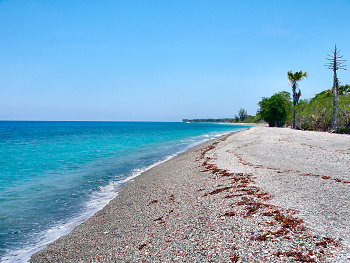
A Beach on the southern coast of Timor Leste.
One of my first sightings during the Tour
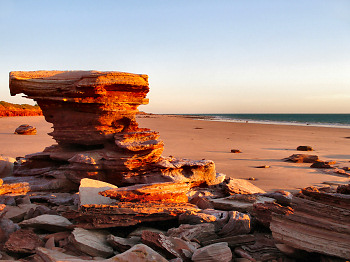
Eroded rocks on a beach at Broome, Western Australia
A Very Grand Journey
Our links to the great ocean began with perhaps the most important transformation our species has yet made; when modern humans left our ancestral home and spread across the globe, eventually occupying all of the lands of the planet. That change affected both us, and the previously unseen lands our ancestors eventually reached, which may never again be the same as they had been up to that time. The first migrations from our birthplace in East Africa began fifty to one hundred thousand years ago, at a time when glaciation was likely in force throughout the northern hemisphere. That factor naturally directed human explorers along the most useful, and indeed probably the only practical, route to new homes; along the northern coasts of the Indian Ocean, eventually reaching the vast land now known as Australia. From linguistic, archeological, and other relationships, it has been believed for some time that this migration had occurred. However, in the years immediately preceding my Tour, important information revealed by genetic analyses seems to have clinched the route and approximate date of this human expansion. Genetic lineages linking the peoples of Africa and Australia were found in places like southern India, the Andaman Islands of the Bay of Bengal, and parts of Southeast Asia. Almost certainly, reaching Australia from Africa was not anyone's plan at the time. More likely, people simply wondered; "Are there more fish and clams beyond the next river outlet?", or "Does that little island over there have any nice fruit trees?" Then, before long, and without anyone realizing that they, and their ancestors, had gone so far: Australia.
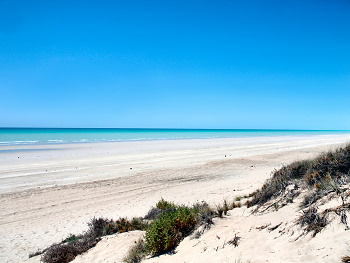
Eight-Mile Beach in Western Australia
Without intending to do so, my route for the first three Stages took me, more or less, on a reverse course of our species' first big journey; from Australia, through Southeast Asia, India, the Great Rift Valley of Africa, and finally to the Cradle of Humanity in Southeastern Africa. It is not very likely that one would meet anyone wholly descended from those original migrants in most of those locations today. However, on a forest trail in Temar Negara National Park in Malaysia, I did encounter a small family of Orang Asli, whose society has some members believed to be the first inhabitants of that area, and in India, from time to time, I did a double take when noticing someone's face that completely resembled some of the original Australians I had seen earlier. Superficial observations like these are probably useless, but you never know, and they were interesting to think about.
Another thing that I found interesting was that the collction of former Gondwanan fragments possesses both the lands on which humans have lived the longest, Africa, India, Australia, among others, and the major lands where we have been present for the shortest length of time. The latter include New Zealand, settled by the Polynesian ancestors of the Maori only seven hundred years ago; and Madagascar, just off the southern African coast settled by the the Malagasy, who left the area of the Indonesian Archipelago by sea, around 1,500 to 2,300 years ago. It is that final migration that I find most interesting. For, after an assuredly perilous journey of over 7,000 kilometers in traditional canoes, the ancestors of the Malagasy completed the circle of human settlements that started tens of thousands of years earlier. The circle that was completed coincides with the margins of the Indian Ocean, reinforcing its relationship to all of us, as one of the last lands occupied by humans lies only a few hundred kilometers from one of the first.
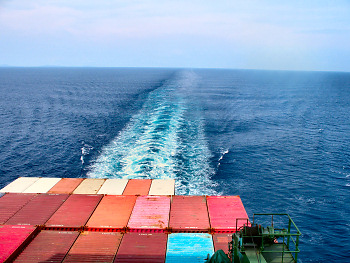
The M.V. Theodor Storm leaves its wake on the Indian Ocean
Historical Waters
Once agricultural civilizations began to be established, the great ocean did not lessen in its importance. In fact, three of the greatest early civilizations were formed near its northern shores; in Sumer, Egypt, and the Indus Valley. Maritime trade between these cultures began at least 5,000 years ago, and was enhanced by the peculiar nature of the seasonal monsoons which provided a distinct aid to sailing vessels wishing to cross the Ocean. As the heat of summer builds over the Indian subcontinent, the southwestern monsoon begins, a constant wind blowing from the southwest to the northeast. When the cooler days of winter return, the winds reverse direction. This facilitated an annual round-trip journey between India and the civilizations of Mesopotamia, the Middle East, and Africa. Few regions of the World possess a climatic pattern that is as advantageous for trade and cultural exchange as that of the northern section of the Indian Ocean. Later civilizations, the Persians, the Axumites, the Arabians, the Malays, and the Cholas, to name just a few, continued the ancient traditions of trade across the great body of water. In fact, even today it is common to see sailing craft made in the traditional way, probably similar to those that have been used for millennia, sailing the Indian Ocean, competing for space with the container ships bound for the Suez Canal and the supertankers carefully threading their way through the Strait of Hormuz.
That the great ocean was the most cosmopolitan region in the early historical World, is revealed by an account from an unnamed "Merchant of the 1st Century," known as the The Periplus of the Erythraean Sea, which briefly describes the harbors and cultures found along its shores. The variety of goods that were exchanged across the sea routes of the great ocean are described in the following passage relating to the port of Barygaza (modern day Bharuch, Gujarat, India):
"There are imported into this market-town, wine, Italian preferred, also Laodicean and Arabian; copper, tin, and lead; coral and topaz; thin clothing and inferior sorts of all kinds; bright-colored girdles a cubit wide; storax, sweet clover, flint glass, realgar, antimony, gold and silver coin, on which there is a profit when exchanged for the money of the country; and ointment, but not very costly and not much. And for the King there are brought into those places very costly vessels of silver, singing boys, beautiful maidens for the harem, fine wines, thin clothing of the finest weaves, and the choicest ointments. There are exported from these places spikenard, costus, bdellium, ivory, agate and carnelian, lycium, cotton cloth of all kinds, silk cloth, mallow cloth, yarn, long pepper and such other things as are brought here from the various market-towns. Those bound for this market-town from Egypt make the voyage favorably about the month of July, that is Epiphi. "
Another passage demonstrates that the local traders of the time were well aware of the geography of Africa, 1,500 years before the western Europeans "discovered" that part of the World:
"Two days' sail beyond, there lies the very last market-town of the continent of Azania, which is called Rhapta; which has its name from the sewed boats (rhapton ploiarion) already mentioned; in which there is ivory in great quantity, and tortoise-shell. Along this coast live men of piratical habits, very great in stature, and under separate chiefs for each place...
There are imported into these markets the lances made at Muza especially for this trade, and hatchets and daggers and awls, and various kinds of glass; and at some places a little wine, and wheat, not for trade, but to serve for getting the good-will of the savages. There are exported from these places a great quantity of ivory, but inferior to that of Adulis, and rhinoceros-horn and tortoise-shell (which is in best demand after that from India), and a little palm-oil.
And these markets of Azania are the very last of the continent that stretches down on the right hand from Berenice; for beyond these places the unexplored ocean curves around toward the west, and running along by the regions to the south of Aethiopia and Libya and Africa, it mingles with the western sea."
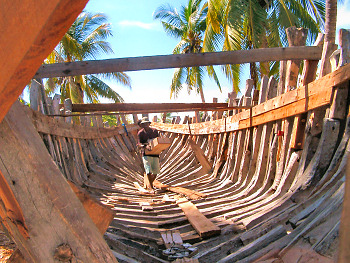
Traditional hand-made wooden boats, like this one being built on the
west coast of Madagascar, are still common around the Indian Ocean
Treacherous Seas
While the great ocean is both beautiful and useful, it is not without its perils. Piracy remains a lingering concern around the Straits of Malacca, and the waters surrounding Somalia. The London Senator, the container ship that, in 02006, transported me aross the Indian Ocean, through the Gulf of Aden and the Red Sea, in order to begin Stage 3, was considered to be too large a ship to be bothered by Somali pirates. At the time, that was true and we passed uneventfully through that area. However, after the Tour was complete, the pirates expanded their capabilities and began hijacking even the largest of ships. For once, my timing proved to be just about right.
However, natural phenomena are of the most concern to the people living along the coastlines of the ocean. Of these, weather events are the most frequent, and most deadly. The Indian Ocean, while not as active as the Pacific overall, possesses three distinct regions which commonly spawn tropical cyclones; the northern zone, mainly in the Bay of Bengal; the southeastern zone, near Australia; and the southwestern zone, near Madagascar. The cyclones above category 3, which spun their way through the Indian Ocean while I was on the Tour, are listed in the sidebar to the right. Of those, the most tragic were the immensely powerful storms Sidr, and Nargis. Both struck after I had left Asia, which is of no relevance to the people who live in that region and who had to deal with their wrath. Both were unusually destructive because they made landfall in low-lying, heavily populated areas. Sidr struck Bangladesh on November 15, 02007, and killed an estimated 10,000 people. Nargis was even more catastrophic, hitting the Ayerawaddy delta region of Myanmar on May 02, 02008, leading to an unfathomable 146,000 deaths. That catastrophe made clear to the World the utter level of incompetence possessed by the generals who continually bungle their unlawful and tyrannical rule of that beautiful country; a fact that the rest of the World seemed to forget in the months after the tragedy had drifted off the daily news wire.
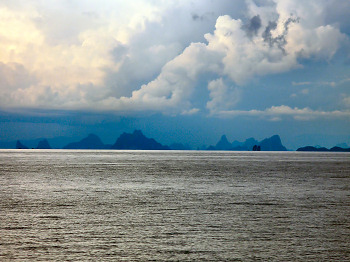
Storms and Karst formations on the west coast of Thailand, near Phuket
One of the most destructive events in modern times was the Indian Ocean Tsunami of December 24, 02004, which struck only 132 days before I began the Tour. I had considered purposefully avoiding the disaster area, so as not to interfere with the recovery, but when I was in Singapore, I met a few people from the affected area of Thailand who led me to believe it would be fine to go there by that time. When I visited a few of the damaged areas, Phuket Thailand, and points to the north, the coast of Tamil Nadu, India, and the east coast of Sri Lanka, most of the mess had been removed, but there were still many shells of abandoned buildings remaining, a testament to the sudden way the coastal communities of the region were shattered. By the time I had reached the former resort town of Kalkudah, Sri Lanka, I had bicycled far enough that I had a pretty good feel for the scale of the great ocean, and became even more amazed that such a wave could maintain its destructive force over such a long distance. I also noticed in astonishment the mangled train car from the Colombo-to-Galle coastal train, on the western coast of the island, which had been left in place, at least for a while, to commemorate the victims there. That made the point quite clearly that even areas on the leeward side of the island, relative to the wave's path, were not spared. I could only imagine the scene I would have seen had I started the Tour a year earlier, as I had hoped.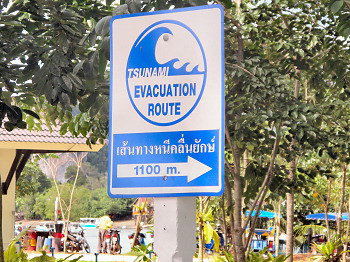
An ominous sign at Krabi beach, Thailand
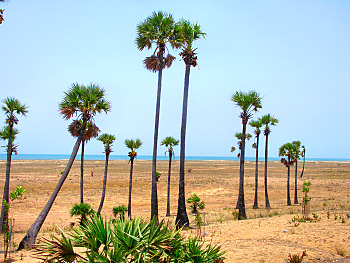
A Tsunami-devastated Beach in Tamil Nadu, India
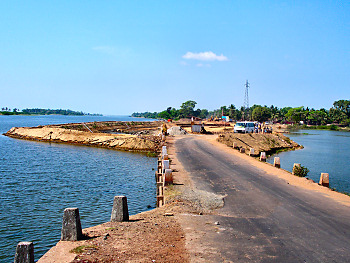
A Tsumani-damaged causeway under repair in eastern Sri Lanka
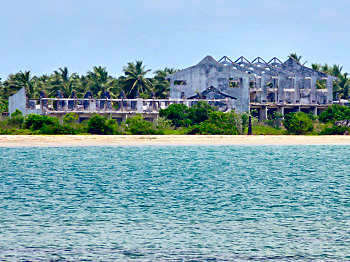
A hotel ruined by the Tsumani near Kalkudah, Sri Lanka
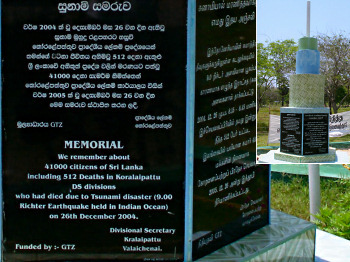
A memorial to Tsunami victims, Kalkudah, Sri Lanka
My Encounters
While I probably did upwards of 25,000 kilometers of cycling in the general vicinity of the coastlines of three continents, actual sightings of the great ocean were disturbingly rare. Like many places, roadways in that part of the World are often sensibly located a considerable distance from the sea. At other times, my route took a course more towards the inland regions, in order for me to explore what they had to offer. Consequently, I learned to appreciate the chance to breathe the salt air of the historic ocean whenever I had the chance. Apart from the two voyages on container ships, which, of course, gave me plenty of time to enjoy the blue open water, it often required a concerted effort to observe the sea.
My encounters in Stage 1 came at a beautiful, but rocky, little beach on Timor Leste, and then at widely-spaced intervals along the coast of Western Australia, south of Broome. Stage 2 should have provided many more opportunities, given the long coastlines of the countries included in the Stage. However, after a rather disappointing stretch along western Malaysia and southwestern Thailand, where rain spoiled most of my beach visits, it was not until much later, in southern India and Sri Lanka, that I finally saw the great ocean under blue, warm skies again. With the game parks and other natural features of the African interior providing the main attractions of Stage 3 I knew that I would have few chances to take a refreshing ocean swim. What opportunities there were did not come until near the end, at Toalagnaro, Madagascar, and at occasional points along the coasts of the Eastern Cape and Western Cape provinces of South Africa. Those sighting proved to be among the most beautiful of all, however. While I was not in constant contact with the great ocean during the three Stages, I did see it along its eastern, northern, and western coastlines, and in mid-ocean while on ships. I feel confident that I can now say that I know that particular body of water very well.
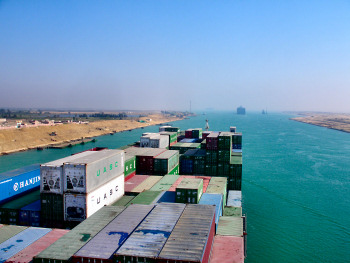
The M.V. London Senator passing through the Suez Canal.
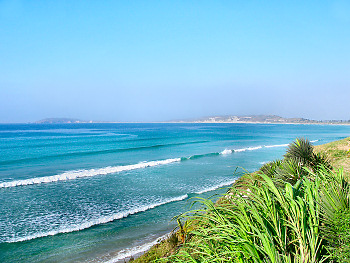
Ths southeastern coast of Madagascar at Toalagnaro
A Worthwhile Change
With that in mind, I humbly put forth an important proposal for the geographic community and the general public as well. The name Indian Ocean has been in use by many cultures for some time now, and is well established. Indeed, certain of the non-Indo-European languages in use by cultures along its coast, Malagasy and Bahasa Melayu, for example, use a unique word for "ocean," but with a cognate of the word "India" to describe the sea. This was not always the case, however, and earlier names included the Sanskrit label Ratnakara, and the Greek moniker, Erythraean Sea. Given that the great ocean holds such an important and ancient relationship to our past, I feel that a new description, one that spans geologic time, speaks to the common heritage of the life found along its shores, and relates to the ocean's very birth, would be much more appropriate. Therefore, I wish to suggest that, from this point forward, the great ocean should be known as
The Gondwanan Ocean.
I realize that there will be much resistance to my suggestion, as, undeniably, there are a great number of maps that must now be changed, school curricula that must be modified, and the general linguistic inertia of the public to be overcome. Moreover, in no way, should this be seen as any sort of disrespect to the nation, or people, of India. Indeed, the very word Gondwana owes its root to the Gondia region of India, where rocks from the ancient supercontinent are found to this day. I urge those reading this page to adopt this change immediately, as I will, in order to help spread this meme worldwide. Though the task may seem a bit quixotic, I will see it through to its eventual success, for once I set my mind upon a task, cycling around the World, for example, I am known to be reluctant to accept less than that.
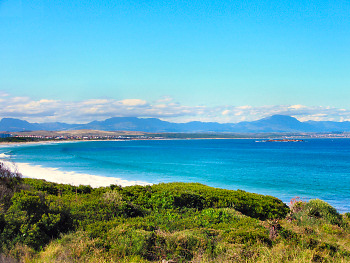
Mossel Bay, South Africa. Where the Gondwanan Ocean mingles
with the Atlantic; my final sighting
Previous | Next
Main Index | Pre-Tour Index
Post-Tour Index | Articles Index
Slideshows
Main Index Pre-Tour Post-Tour Articles Previous Next |
Facts & Figures
Surface Area
73.6 x 106 km2
Estimated Volume
292.1 x 106 km3
Mean Depth
3,890 m
Greatest Depth
7,725 m below mean sea level at the Java Trench
Length of Coastline
66,526 km
Countries with coastline
~ Australia
~ Timor Leste
~ Indonesia
~ Malaysia
~ Thailand
~ Myanmar
~ Bangladesh
~ India
~ Pakistan
~ Iran
~ Iraq
~ Kuwait
~ Saudi Arabia
~ Qatar
~ United Arab Emirates
~ Oman
~ Yemen
~ Egypt
~ Sudan
~ Eritrea
~ Djibouti
~ Somalia
~ Kenya
~ Tanzania
~ Mozambique
~ South Africa
Island Nations
~ Sri Lanka
~ Maldives
~ Bahrain
~ Seychelles
~ Comoros
~ Mauritius
~ Madagascar
Major Ports
~Melbourne
~Adelaide
~Fremantle
~Darwin
~Jakarta
~Port Kelang
~Chittagong
~Kolkata
~Chennai
~Colombo
~Mumbai
~Karachi
~Jebel Ali
~Khor Fakan
~Jeddha
~Mombasa
~Dar es Salam
~Toamasina
~Port Louis
~Durban
Major Storms
Following is a list of Tropical Cylcones at Category 3, or greater, during the years of the Tour:
Bertie-Alvin; Nov. '05; Max. Cat. 4; No Landfall
Floyd; Mar. '06; Max. Cat. 4; No Landfall
Glenda; Mar. '06; Max. Cat. 4; Landfall at Onslow, W.A.
Mala; Apr. '06; Max. Cat. 4; Landfall west of Yangon
Bondo; Dec. '06; Max. Cat. 4; Landfall in NW Madagascar
Favio; Feb. '07; Max. Cat. 4; Landfall at Vilanculos, Mozambique
George; Feb. '07; Max. Cat. 3; Landfall in Kimberley Region, W.A.
Dora; Feb. '07; Max. Cat. 4; No Landfall
Kara; Mar. '07; Max. Cat. 4; No Landfall
Gamede; Mar. '07; Max. Cat. 3; No Landfall
Indlala; Mar. '07; Max. Cat. 4; Landfall at Antalaha Madagascar
Jaya; Apr. '07; Max. Cat. 3; Landfall at Sambava Madagascar
Gonu; Jun. '07; Max. Cat. 5; Landfall in eastern Oman
Sidr; Nov. '07; Max. Cat. 5; Landfall in the Sunderban, Bangladesh
Hondo; Feb. '08; Max. Cat. 4; No Landfall
Ivan; Feb. '08; Max. Cat. 4; Landfall at Fanoarivo, Madagascar
Jokwe; Mar. '08; Max. Cat. 3; Landfall at Angoche Island, Mozambique
Kamba; Mar. '08; Max. Cat. 4; No Landfall
Pancho; Mar. '08; Max. Cat. 3; No Landfall
Nargis; Apr. '08; Max. Cat. 4; Landfall west of Yangon